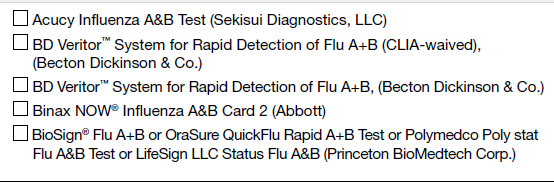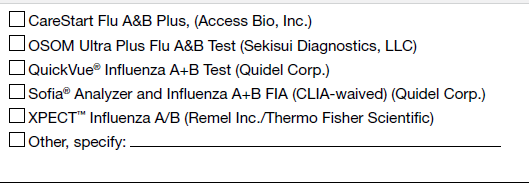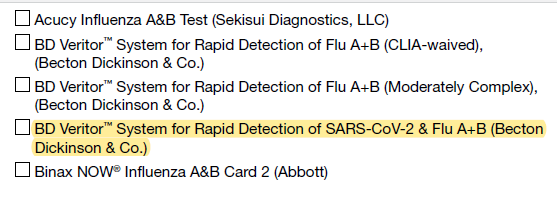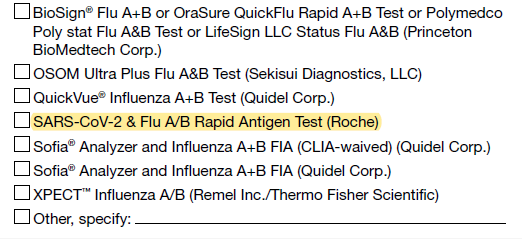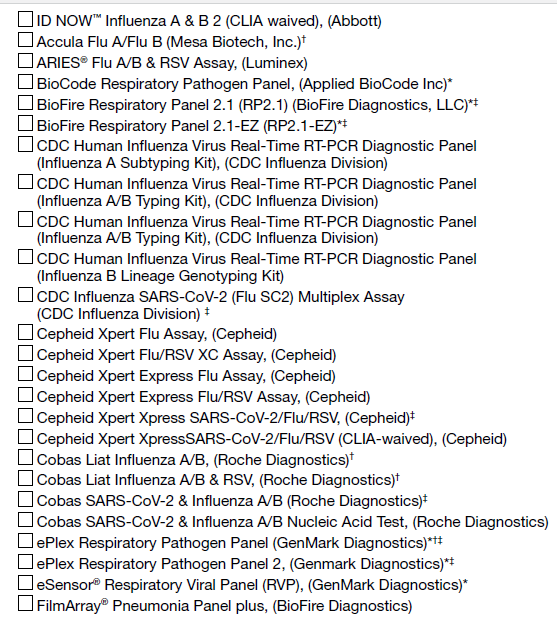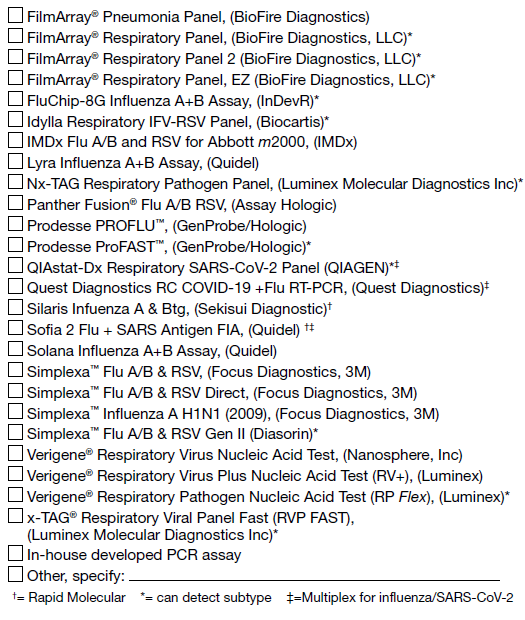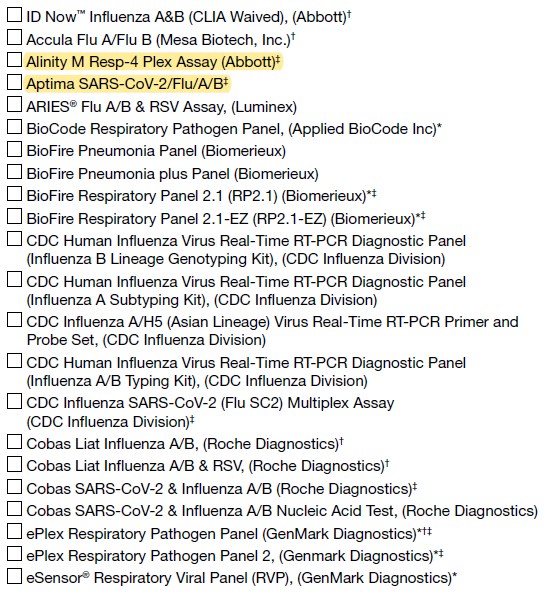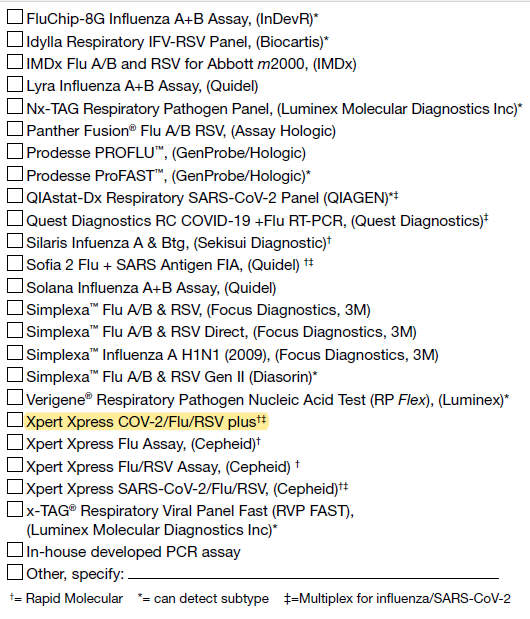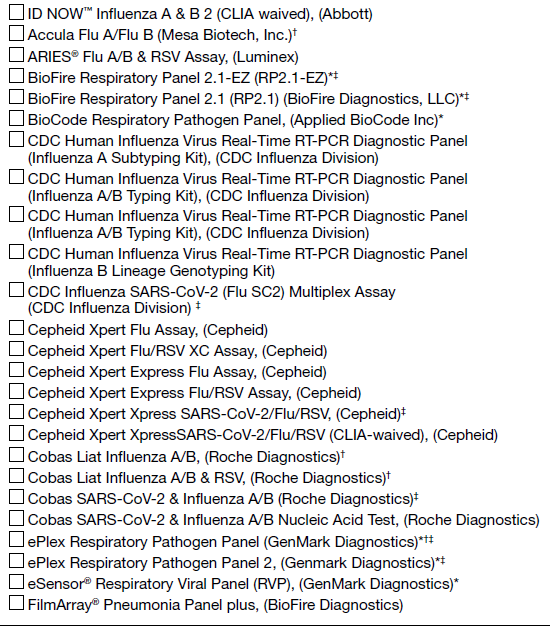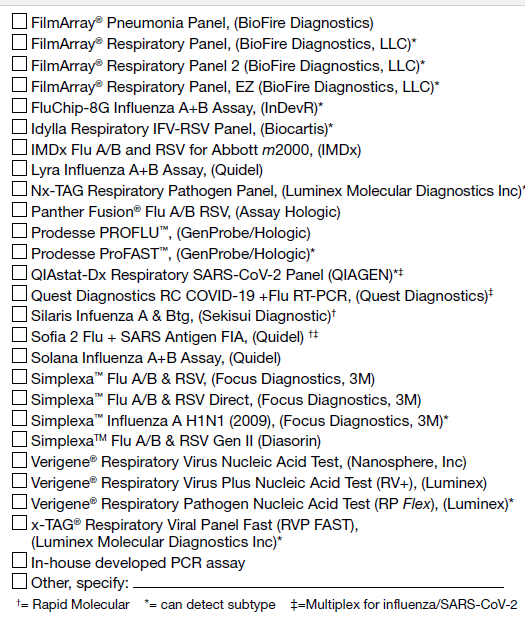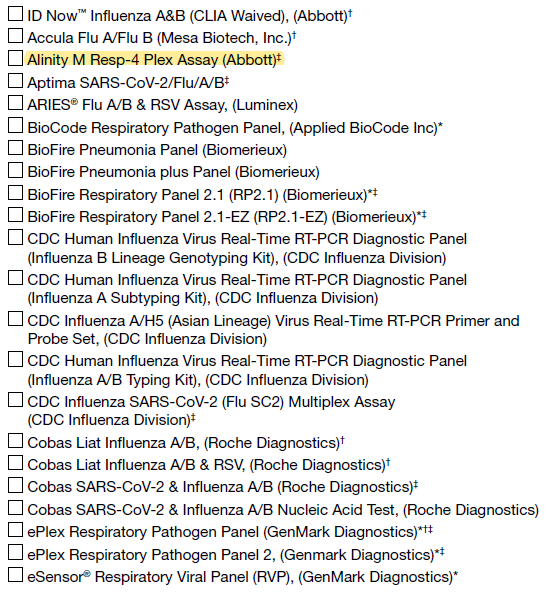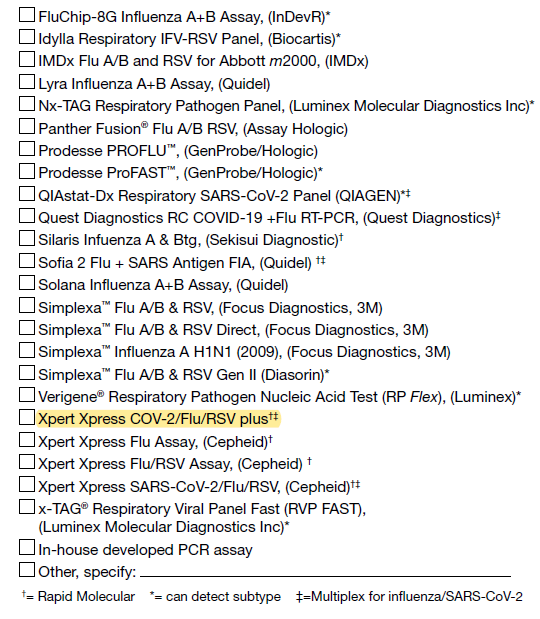Non-Substantial Change Request _Crosswalk
Att2_EIP2023_NonSub_Crosswalk_OCT2022.docx
[NCEZID] Emerging Infections Program
Non-Substantial Change Request _Crosswalk
OMB: 0920-0978
Cross walk - 2023 form changes
FoodNet
FoodNet Active Surveillance Data Elements List – Attachment #3
Refer to Attachment #3 - Changes are highlighted in Yellow
FoodNet Hemolytic Uremic Syndrome Data Elements List – Attachment #4
Refer to Attachment #4 - Changes are highlighted in Yellow
Diagnostic Laboratory Practices and Volume Elements List – Attachment #5
Refer to Attachment #5 – Changes are highlighted in Yellow
FluSurv-Net
FluSurv-NET Influenza Surveillance Project Case Report Form– Attachment #6
Question on 2021-22 Form |
Question on 2022-23 Form |
C9. Race:
|
C8. Race (select all that apply):
|
C2. Admission Type
|
Deleted question C2 regarding Admission Type |
HIj. Pregnant
|
C12. Pregnant (15-49 years of age only):
|
This question was not present |
H 10. Mental Health Conditions [] Yes [] No/Unknown
|
I1. Were any culture tests performed within 7 days of admission? (for patients that died in the hospital, include culture tests performed either 1) within 7 days of admission, 2) within 3 days prior to death, or 3) within 24 hours after death?
|
I1 Were any culture tests performed within 3 days prior to or 3 days following admission
|
J1. Was the patient tested for any viral pathogen within 14 days prior to or within 7 days of admission?
|
J1. Was the patient tested for any viral pathogen within 14 days prior to or within <= 3 days after admission?
Unknown |
I2. If yes, was there a positive culture for aspergillus, mucormycosis, or a bacterial pathogen?
|
I2c. Result of culture
|
I2a. If yes, specify pathogen
|
I2d. If positive, what pathogen was identified?
|
K2C. Treatment End Date
|
This question was deleted |
M1. Did the patient have any of the following new diagnoses at discharge (select all that apply) |
M1. Did the patient have any of the following new diagnoses at discharge (select all that apply)
|
FluSurv-NET/RSV Laboratory Survey– Attachment #7
Question on 2021-22 form |
Question on 2022-23 form |
4a. Select the kit names for the rapid influenza diagnostic tests performed or planned to be used at the laboratory (check all that apply)
|
4a. Select the kit names for the rapid influenza diagnostic tests performed or planned to be used at the laboratory (check all that apply)
|
5A. Select Kit names for all molecular assays performed or planned to be used at the laboratory (check all that apply)
|
5A. Select Kit names for all molecular assays performed or planned to be used at the laboratory (check all that apply)
|
5B If more than one kit is selected above, please select the one kit name that is (or will be) used most frequently for molecular assay at the laboratory during the current influenza season:
|
5B If more than one kit is selected above, please select the one kit name that is (or will be) used most frequently for molecular assay at the laboratory during the current influenza season:
|
6A. Which influenza test method does the laboratory perform most frequently for pediatric patients (0-17 years)?
|
6A. Which influenza test method does the laboratory perform most frequently for pediatric patients (0-17 years)?
|
6B. Which influenza test method does the laboratory perform most frequently for adult patients (aged >= 18 years)?
|
6B. Which influenza test method does the laboratory perform most frequently for adult patients (aged >= 18 years)?
|
7. Based on tests that were performed during the 2021-2022 influenza season, approximately what percent of the time are each of these test types used to test for flu overall
|
7. Based on tests that were performed during the 2021-2022 influenza season, approximately what percent of the time are each of these test types used to test for flu overall
|
HAIC
HAIC: Invasive Methicillin-resistant Staphylococcus aureus (MRSA) Infection Case Report Form (Attachment #9)
2022 CRF Question |
Changes to the 2023 CRF Question |
|
2a. Planning region |
34a. Did the patient have a positive test(s) for SARS-CoV-2 (molecular assay, serology, or other confirmatory test) on or in the year before the DISC? □ Yes □ No □ Unknown |
34a. Did the patient have a positive test(s) for SARS-CoV-2 (molecular assay, serology, or other confirmatory test) on or in the 90 days before the DISC? □ Yes □ No □ Unknown |
34a. IF YES, complete below for MOST RECENT positive test for SARS-CoV-2 on or in the year before the DISC: Specimen collection date: __-__-____ □ Unknown Test type: □ Antigen □ Molecular assay □ Serology □ Method unknown □ Other (specify): ________ |
34a. Specimen collection dates for positive tests in the 90 days before or day of DISC: First positive test: __-__-____ □ Unknown Most recent positive test: __-__-____ □ Unknown
|
34a. COVIDNET Case ID: _____________ NNDSS IDs (please provide at least one of the following when applicable): CDC 2019 NCOV ID: _____________ Local case ID: _____________ Local record ID: _____________ State case identifier: _____________ Legacy case identifier: _____________ |
34a. COVIDNET Case ID: _____________
|
HAIC: Invasive Methicillin-sensitive Staphylococcus aureus (MSSA) Infection Case Report Form (Attachment #10)
2022 CRF Question |
Changes to the 2023 CRF Question |
|
2a. Planning Region |
34a. Did the patient have a positive test(s) for SARS-CoV-2 (molecular assay, serology, or other confirmatory test) on or in the year before the DISC? □ Yes □ No □ Unknown |
34a. Did the patient have a positive test(s) for SARS-CoV-2 (molecular assay, serology, or other confirmatory test) on or in the 90 days before the DISC? □ Yes □ No □ Unknown |
34a. IF YES, complete below for MOST RECENT positive test for SARS-CoV-2 on or in the year before the DISC: Specimen collection date: __-__-____ □ Unknown Test type: □ Antigen □ Molecular assay □ Serology □ Method unknown □ Other (specify): ________ |
34a. Specimen collection dates for positive tests in the 90 days before or day of DISC: First positive test: __-__-____ □ Unknown Most recent positive test: __-__-____ □ Unknown
|
34a. COVIDNET Case ID: _____________ NNDSS IDs (please provide at least one of the following when applicable): CDC 2019 NCOV ID: _____________ Local case ID: _____________ Local record ID: _____________ State case identifier: _____________ Legacy case identifier: _____________ |
34a. COVIDNET Case ID: _____________
|
HAIC: Extended-Spectrum Beta-Lactamase (ESBL)-Producing Enterobacterales / Invasive Escherichia coli (iEC) Multi-site Gram-Negative Surveillance Initiative (MuGSI) Case Report Form (CRF) (Attachment #11)
HAIC: Carbapenem-Resistant Enterobacterales (CRE) and Carbapenem-Resistant Acinetobacter baumannii (CRAB) Multi-site Gram-Negative Surveillance Initiative (MuGSI) Case Report Form (CRF) (Attachment #12)
Question on original 2022 form |
Question on 2023 form |
Description of change |
||||||||||||
2022 Carbapenem Resistant Enterobacteriaceae (CRE)/ Carbapenem Resistant A. baumannii (CRAB) Multi-site Gram-Negative Surveillance Initiative (MuGSI) Healthcare-Associated Infections Community Interface (HAIC) Case Report |
2023 Carbapenem Resistant Enterobacterales (CRE)/ Carbapenem Resistant A. baumannii (CRAB) Multi-site Gram-Negative Surveillance Initiative (MuGSI) Healthcare-Associated Infections Community Interface (HAIC) Case Report |
I. Updated the year to 2023 II. Updated Enterobacteriaceae to Enterobacterales |
||||||||||||
Q2. County |
Q2a. County |
I. Updated the question number |
||||||||||||
|
Q2b. Planning region |
I. Added question |
||||||||||||
23b. Risk factors in the 7 days before the DISC: ð Non-invasive positive pressure ventilation (CPAP or BiPAP) at any time in the 7 calendar days before the DISC ð Nebulizer treatment at any time in the 7 calendar days before the DISC ð Mechanical ventilation at any time in the 7 calendar days before the DISC |
23b. Risk factors in the 7 days before the DISC: ð Non-invasive positive pressure ventilation (CPAP or BiPAP) at any time in the 7 calendar days before the DISC ð Nebulizer treatment at any time in the 7 calendar days before the DISC ð Mechanical ventilation at any time in the 7 calendar days before the DISC ð None |
I. Added a checkbox for “none”
|
||||||||||||
24a. Did the patient have a positive test(s) for SARS-CoV-2 (molecular assay, serology, or other confirmatory test) in the year before or day of the DISC? ð Yes ð No ð Unknown |
24a. Did the patient have a positive test(s) for SARS-CoV-2 (molecular assay, antigen, or other viral test, excluding serology) in the 90 days before or day of the DISC? ð Yes ð No ð Unknown |
i. Updated the text for the question
|
||||||||||||
24b. If yes, complete the table below for the most recent positive SARS-CoV-2 test in the year before or day of the DISC:
|
24b. Specimen collection dates for positive tests in the 90 days before or day of DISC:
|
i. Updated the text for the question ii. Removed the test type iii. Added specimen collection date for first and most recent positive test
|
HAIC: CDI Case Report and Treatment Form (Attachment #13)
2022 CRF |
2023 CRF |
Changes |
6. County |
6a. County |
changed question number |
[question not on CRF] |
6b. Planning region |
new question |
36. Previous unique CDI episode |
38. Previous unique CDI episode |
changed question number |
37. Any recurrent C. diff+ episodes following this incident C. diff+ episode? |
39. Any recurrent C. diff+ episodes following this incident C. diff+ episode? |
changed question number |
37a.
If YES, Date of first |
39a.
If YES, Date of first |
changed question number |
38. CRF status |
40. CRF status |
changed question number |
39. Initials of SO |
41. Initials of SO |
changed question number |
40. Date of abstraction |
42. Date of abstraction |
changed question number |
41. Did the patient have a positive test(s) for SARS-CoV-2 (molecular assay, serology, or other confirmatory test) in the year before or day of the DISC? |
36. Did the patient have a positive test(s) for SARS-CoV-2 (molecular assay, antigen, or other viral test; excluding serology) in the 90 days before or day of the DISC? |
changed question number, changed time period, changed tests under consideration |
[question not on CRF] |
36a.
[Specimen collection dates for positive tests in the 90 days
before or day of DISC] |
new question |
41a.1 [If YES, complete below for most recent positive test for SARS CoV-2 in the year before or date of the DISC] - Specimen collection date |
36b.
[Specimen collection dates for positive tests in the 90 days
before or day of DISC] |
Reworded, changed time period |
41a.2 [If YES, complete below for most recent positive test for SARS CoV-2 in the year before or date of the DISC] - Test type |
[question not on CRF] |
Removed question |
42a. COVID-NET Case ID |
37. COVID-NET Case ID |
changed question number |
42b. NNDSS IDs |
[question not on CRF] |
Removed question |
HAIC: CDI Annual Surveillance Officers Survey (Attachment #14)
Existing question |
Modified question |
2. In 2021, did any laboratories drop out of participation? |
2. In 2022, did any laboratories drop out of participation? (changed year to 2022 to reflect change in survey year) |
3. In 2021, did you identify any additional laboratories inside or outside of your catchment area which identify C.diff assays from persons who are residents of your catchment area? |
3. In 2022, did you identify any additional laboratories inside or outside of your catchment area which identify C.diff assays from persons who are residents of your catchment area? (changed year to 2022 to reflect change in survey year) |
10. Did your site complete a physician/outpatient provider survey in 2021? |
10. Did your site complete a physician/outpatient provider survey in 2022? (changed year to 2022 to reflect change in survey year) |
13. For each facility that treated a case in 2021, please provide the following |
13. For each facility that treated a case in 2022, please provide the following (changed year to 2022 to reflect change in survey year) |
HAIC: Annual Survey of Laboratory Testing Practices for C. difficile Infections (Attachment #15)
2022 |
2023 |
Changes |
Was this a new laboratory in 2021? |
Was this a new laboratory in 2022? |
Changed year to 2022 to reflect change in survey year |
Did this lab participate in surveillance in 2021? |
Did this lab participate in surveillance in 2022? |
Changed year to 2022 to reflect change in survey year |
How often did you receive line lists from this lab in 2021? |
How often did you receive line lists from this lab in 2022? |
Changed year to 2022 to reflect change in survey year |
How did you receive line lists from this lab in 2021? |
How did you receive line lists from this lab in 2022? |
Changed year to 2022 to reflect change in survey year |
Did you receive specimens from this lab in 2021? |
Did you receive specimens from this lab in 2022? |
Changed year to 2022 to reflect change in survey year |
Was this lab audited in 2021? |
Was this lab audited in 2022? |
Changed year to 2022 to reflect change in survey year |
Types of facilities in your catchment area served by this lab in 2021 |
Types of facilities in your catchment area served by this lab in 2022 |
Changed year to 2022 to reflect change in survey year |
1. Did your laboratory ever send specimens off-site for Clostridioides difficile testing in 2021? |
1. Did your laboratory ever send specimens off-site for Clostridioides difficile testing in 2022? |
Changed year to 2022 to reflect change in survey year |
2.
What type and order of testing was routinely used by your
laboratory in standard testing for C. difficile on December 31,
2021? |
[question not on survey] |
Removed question |
2a. Which specimens were used during your 2nd line of testing? |
[question not on survey] |
Removed question |
2b. Which specimens were used during your 3rd line of testing? |
[question not on survey] |
Removed question |
2c. Did your laboratory perform any onsite testing for C. difficile outside of your normal testing algorithm in 2021? |
[question not on survey] |
Removed question |
[question not on survey] |
[Question 2a is a table with this heading] Which testing method(s) for Clostridioides difficile (C. difficile) did your laboratory perform in 2022? (Choose all that apply. Include testing methods used for only part of the year or for only a specific subset of specimens, if applicable) |
Added table of questions |
[question not on survey] |
Did your laboratory use this testing method for Clostridioides difficile (C. difficile) in 2022? |
Added table of questions |
[question not on survey] |
[For each testing method selected] Specify when you used this test (e.g. at provider request, for outpatients, for inpatients with a length of stay > 3 days, for every specimen received) |
Added table of questions |
[question not on survey] |
[For each testing method selected] Did you use this testing method in this way for all of 2022? |
Added table of questions |
[question not on survey] |
[For each testing method selected] What date did you change? |
Added table of questions |
[question not on survey] |
[For each testing method selected] What test did you use in this situation before this date? |
Added table of questions |
3a. Which EIA test kit was used by your laboratory in 2021? |
3a. Which EIA test kit was used by your laboratory in 2022? |
Changed year to 2022 to reflect change in survey year |
3b. Which Nucleic Acid Amplification test was used by your laboratory in 2021? |
3b. Which Nucleic Acid Amplification test was used by your laboratory in 2022? |
Changed year to 2022 to reflect change in survey year |
4a. If your laboratory used a multiplexed molecular diagnostic (e.g., Biofire Filmarray GI Panel, Luminex xTAG GPP) to test for several GI pathogens in 2021, did your laboratory suppress the C. difficile result so that clinicians could not see it? |
4a. If your laboratory used a multiplexed molecular diagnostic (e.g., Biofire Filmarray GI Panel, Luminex xTAG GPP) to test for several GI pathogens in 2022, did your laboratory suppress the C. difficile result so that clinicians could not see it? |
Changed year to 2022 to reflect change in survey year |
4b. If your laboratory used a multiplexed diagnostic in 2022 and the result was suppressed, where does the suppression occur? |
4b. If your laboratory used a multiplexed diagnostic in 2022 and the result was suppressed, where does the suppression occur? |
Changed year to 2022 to reflect change in survey year |
5a. If your laboratory used a nucleic acid amplification test (NAAT) (e.g., Cepheid Xpert C. difficile) as first line testing followed by a toxin EIA test (whenever NAAT result is positive) in 2022, did your laboratory suppress the positive NAAT result so that clinicians could not see it? |
5a. If your laboratory used a nucleic acid amplification test (NAAT) (e.g., Cepheid Xpert C. difficile) as first line testing followed by a toxin EIA test (whenever NAAT result is positive) in 2022, did your laboratory suppress the positive NAAT result so that clinicians could not see it? |
Changed year to 2022 to reflect change in survey year |
5b. If your laboratory used NAAT as first line testing followed by confirmatory toxin EIA testing in 2022, and both the NAAT and toxin EIA results were released to the clinician, did your laboratory provide any comments to help the clinician interpret the test results (e.g., NAAT-positive only result might represent colonization, etc.)? |
5b. If your laboratory used NAAT as first line testing followed by confirmatory toxin EIA testing in 2022, and both the NAAT and toxin EIA results were released to the clinician, did your laboratory provide any comments to help the clinician interpret the test results (e.g., NAAT-positive only result might represent colonization, etc.)? |
Changed year to 2022 to reflect change in survey year |
6. What are the LOINC or internal testing codes associated with the tests your lab used in 2022 (e.g. LOINC codes 13957-6, 34713-8, or 54067-4)? |
6. What are the LOINC or internal testing codes associated with the tests your lab used in 2022 (e.g. LOINC codes 13957-6, 34713-8, or 54067-4)? |
Changed year to 2022 to reflect change in survey year |
7a. In 2021, did your laboratory experience any shortages in supplies, reagents, and/or test kits for performing C. difficile testing (e.g., NAAT or EIA reagents, swabs)? |
[question not on survey] |
Removed question |
7b. If your laboratory experienced a supply shortage for C. difficile testing in 2021, how did the shortage affect your laboratory’s ability to perform C. difficile testing? |
[question not on survey] |
Removed question |
7c. In 2021, did your laboratory experience a high demand for COVID-19 testing that limited the availability of staff (e.g., reduced staffing or work time) or the use of equipment to perform C. difficile testing? |
[question not on survey] |
Removed question |
8. Did your lab testing algorithm for C. difficile change between January 1, 2021 and December 31, 2021? |
[question not on survey] |
Removed question |
What date did this change occur? ______ / ______ / _____ |
[question not on survey] |
Removed question |
8a.
What was the previous type and order of testing performed by your
lab in 2021 before it changed its testing algorithm? |
[question not on survey] |
Removed question |
8b. Which specimens were used during your 2nd line of testing? |
[question not on survey] |
Removed question |
8c. Which specimens were used during your 3rd line of testing? |
[question not on survey] |
Removed question |
9.
Did your lab have a policy to reject stool specimens for C.
difficile testing in 2021? (Read all options. Check all that
apply) |
7.
Did your lab have a policy to reject stool specimens for C.
difficile testing in 2022? (Read all options. Check all that
apply, even if it only applies sometimes) |
Changed year to 2022 to reflect change in survey year, simplified response options, renumbered question |
9a. Did your rejection policy for stool specimens change between January 1, 2021 and December 31, 2021? |
7a. Did your rejection policy for stool specimens change between January 1, 2022 and December 31, 2022? |
Changed year to 2022 to reflect change in survey year, renumbered question |
10. How many stool samples did you test for C. difficile each month in 2021? |
8. How many stool samples did you test for C. difficile each month in 2022? |
Changed year to 2022 to reflect change in survey year, renumbered question |
HAIC: Candidemia Case Report (Attachment #16)
2022 CRF Question |
2023 CRF Question |
CANDIDEMIA 2022 CASE REPORT FORM (header)
|
CANDIDEMIA 2023 CASE REPORT FORM (header) (changed year) |
Version: Short Form 2022, Last Updated: 07/17/2021 (footnotes)
|
Version: Short Form 2023, Last Updated: 07/29/2022 (footnotes) (changed year and date) |
23. Incident Specimen Collection Site (check all that apply): Blood, Central line Blood, Peripheral stick Blood, not specified Other (specify):____________ Unknown |
(removed question) |
Question 24-25 |
(changed number by 1) |
New Question |
25. Did the patient have a culture-independent diagnostic test (CIDT) for Candida, (eg: T2), on the day of or in the 6 days before the DISC? 1 Yes 0 No 9 Unknown
25a. If yes, test type: ______________________ 25b. Result: ______________________________
(new question) |
30. Infection with Clostridioides difficile on the day of or in the 89 days before or 29 days after the DISC: 1 Yes 0 No 9 Unknown 30a. If yes, date of first C. diff diagnosis: ___ ___ - ___ ___ - ___ ___ ___ ___ Unknown |
(removed question) |
31. Did the patient have any of the following types of infection/colonization related to their Candida infection? (check all that apply): None Unknown Abdominal Hepatobiliary or pancreatic GI tract Abscess (specify): _________ Peritonitis/peritoneal fluid Splenic Candiduria Esophagitis Oral/thrush Osteomyelitis Skin lesions/wounds Pulmonary Abscess Respiratory specimen with Candida CNS involvement (meningitis, brain abscess) Eyes (endophthalmitis or chorioretinitis) Endocarditis Septic emboli (specify location): _________ Other (specify): __________
|
30. Did the patient have any of the following types of infection related to their Candida infection? (check all that apply): None Unknown Abdominal infection Hepatobiliary or pancreatic Abscess (specify): _________ Peritonitis/peritoneal fluid Splenic Urinary tract infection Esophagitis Oral/thrush Osteomyelitis Skin/wound infection Pulmonary infection Abscess CNS infection (meningitis, brain abscess) Eyes Endophthalmitis Chorioretinitis Endocarditis Septic emboli (specify location): _________ Other (specify): __________ (changed question number, question wording, response options) |
Question 32-34
|
(changed number by 1) |
35. Did the patient receive invasive mechanical ventilation in the 30 days before the DISC, not including the DISC? 1 Yes 0 No 9 Unknown |
(removed question) |
Question 36-37a
|
(changed number by 2) |
38. Did the patient have any of the following classes or specific ICD-10 codes, including any sub-codes for this hospitalization? (Check all that apply): None Unknown B37 (candidiasis) Specify sub-code: ___________________ Specify sub-code: ___________________ P37.5 (neonatal candidiasis) B48 (other mycoses, not classified elsewhere) B49 (unspecified mycoses) T80.211 (BSI due to central venous catheter) A41.9 (sepsis, unspecified organism) R65.2 (severe sepsis) Other Candida-related code Specify code: ___________________ |
36. Did the patient have any of the following classes or specific ICD-10 codes, including any sub-codes for this hospitalization? (Check all that apply): None Unknown Not applicable (i.e., patient not hospitalized) B37 (candidiasis) Specify sub-code: ___________________ Specify sub-code: ___________________ P37.5 (neonatal candidiasis) B48 (other mycoses, not classified elsewhere) B49 (unspecified mycoses) T80.211 (BSI due to central venous catheter) A41.9 (sepsis, unspecified organism) R65.2 (severe sepsis) Other Candida-related code Specify code: ___________________
(changed question number, added check box option for not applicable) |
Question 39-44
|
(changed number by 2) |
45. Other Substances (Check all that apply): Mode of Delivery (Check all that apply): IDU Skin popping Non-IDU Unknown IDU Skin popping Non-IDU Unknown IDU Skin popping Non-IDU Unknown IDU Skin popping Non-IDU Unknown IDU Skin popping Non-IDU Unknown IDU Skin popping Non-IDU Unknown IDU Skin popping Non-IDU Unknown IDU Skin popping Non-IDU Unknown
|
43. Other Substances (Check all that apply): Mode of Delivery (Check all that apply): IDU Non-IDU Unknown IDU Non-IDU Unknown IDU Non-IDU Unknown IDU Non-IDU Unknown IDU Non-IDU Unknown IDU Non-IDU Unknown IDU Non-IDU Unknown IDU Non-IDU Unknown
(changed question number, removed “Skin popping” as an option) |
Question 46-50
|
(changed number by 2) |
New Question |
49. Did the patient have any ostomies of the gastrointestinal tract including ileostomy, colostomy, etc. in the 30 calendar days before, not including the DISC? 1 Yes 0 No 9 Unknown |
Question 51-53a
|
(changed number by 2) |
53b. Were all CVCs removed or changed on the day of or in the 6 days after the DISC? 1 Yes 2 No 3 CVC removed, but can’t find dates 5 Died or discharged before indwelling catheter replaced 9 Unknown
|
52b. Were all CVCs removed or changed in the 2 days before or in the 6 days after the DISC? 1 Yes 2 No 3 CVC removed, but can’t find dates 5 Died or discharged before indwelling catheter replaced 9 Unknown
(changed question number and question wording) |
Question 54-55
|
(changed number by 1) |
56. Did the patient have a positive SARS-CoV-2 test result (molecular assay, serology, or other confirmatory test) from a specimen collected in the 90 days before the DISC or on the DISC? 1 Yes 0 No 9 Unknown |
55. Did the patient have a positive SARS-CoV-2 test result (molecular assay, antigen, or other confirmatory test, excluding serology) from a specimen collected in the 90 days before the DISC or on the DISC? 1 Yes 0 No 9 Unknown
(changed question number and question wording) |
Question 56a-58
|
(changed number by 1) |
58a. If yes, what was the reason steroids were administered? (check all that apply) Steroid(s) given as an outpatient medication Steroid(s) given during hospitalization associated with candidemia episode prior to Candida DISC Steroid(s) given as part of treatment/management for COVID-19
|
57a. If yes, what was the reason steroids were administered? (check all that apply) Steroid(s) given as an outpatient medication Steroid(s) given, prior to Candida DISC, during hospitalization associated with candidemia episode Steroid(s) given as part of treatment/management for COVID-19 None of the above
(changed question number and response wording, added check box for additional response option) |
Question 59 |
(changed number by 1) |
60. Did the patient receive any of the following immunomodulatory drugs in the 30 days before the DISC, not including the DISC? (check all that apply) None Tocilizumab Sarilumab Baricitinib Unknown
60a. If yes were any of the immunomodulatory drugs given as part of treatment/management for COVID-19? 1 Yes 0 No 9 Unknown |
(removed questions) |
Question 61-65 |
(changed number by 2) |
New Question |
64. Did the patient have an echocardiogram (ECHO), including transthoracic (TTE) or transesophogeal (TEE), on the day of or 13 days after the DISC? 1 Yes 0 No 9 Unknown |
New Question |
65. Did the patient have a dilated fundoscopic eye exam on the day of or 13 days after the DISC? 1 Yes 0 No 9 Unknown |
HAIC: Laboratory Testing Practices for Candidemia Questionnaire (Attachment #17)
2022 Lab Survey Question |
2023 Lab Survey Question |
2022 LABORATORY TESTING PRACTICES FOR CANDIDEMIA QUESTIONNAIRE (header)
|
2023 LABORATORY TESTING PRACTICES FOR CANDIDEMIA QUESTIONNAIRE (header)
(changed year) |
Hospital laboratory Commercial laboratory (Quest, etc.) Other (specify) ______________________ Unknown
|
Hospital laboratory Commercial laboratory (Quest, etc.) Other (specify) ______________________ Unknown
(changed question wording to remove “facility”) |
Yes No Unknown
|
Yes No Unknown
(changed question wording to replace “facility” with “laboratory”) |
Specify number: ______________ Unknown |
Specify number: ______________ Unknown
(changed question wording) |
Specify number: ______________ Unknown |
Specify number: ______________ Unknown
(changed question wording) |
Yes No (-------- If No, SKIP TO QUESTION 15 --------) Unknown (is there another laboratory staff member who can assist with the questionnaire?)
|
Yes No (-------- If No, SKIP TO QUESTION 18 --------) Unknown (is there another laboratory staff member who can assist with the questionnaire?)
(added paratheses to question wording, updated skip logic in response options) |
Yes No Unknown
|
Yes No Unknown
(changed question wording to replace “Chromagar” with “chromogenic agar”) |
Yes, reflexively Yes, with clinician order No Unknown
|
Yes, always Yes, with clinician order No Unknown
(changed first response option wording) |
Yes, reflexively Yes, with clinician order No Unknown
|
Yes, always Yes, with clinician order No Unknown
(changed first response option wording) |
Yes, reflexively Yes, with clinician order No Unknown
|
Yes, always Yes, with clinician order No Unknown
(changed first response option wording) |
Yes, reflexively Yes, with clinician order No Unknown
|
Yes, always Yes, with clinician order No Unknown
(changed first response option wording) |
Yes, reflexively Yes, with clinician order No Unknown
|
Yes, always Yes, with clinician order No Unknown
(changed first response option wording) |
Yes, reflexively Yes, with clinician order No Unknown
|
Yes, always Yes, with clinician order No Unknown
(changed first response option wording) |
Yes (got to q14) No (got to q17) Unknown
|
Yes (go to Q14) No (go to Q17) Unknown
(changed question wording to update CIDT abbreviation, changed formatting of skip logic in the response wording) |
14) Does this laboratory employ the T2Candida Panel to identify Candida from blood specimens?
Yes (got to 12a) No (go to 13) Unknown
|
14) Does this laboratory employ the T2Candida Panel to identify Candida from blood specimens?
Yes (go to Q14a) No (go to Q15) Unknown
(changed formatting of skip logic in the response wording) |
14) Does this laboratory employ the T2Candida Panel to identify Candida from blood specimens?
Yes, reflexively Yes, with a clinical order No Unknown
|
14) Does this laboratory employ the T2Candida Panel to identify Candida from blood specimens?
Yes, always Yes, with a clinical order No Unknown
(changed question wording, changed first response option wording) |
15) Does this laboratory employ the BioFire (FilmArray) to identify Candida from blood specimens?
Yes (go to 15a) No (go to 16) Unknown
|
15) Does this laboratory employ the BioFire (FilmArray) to identify Candida from blood specimens?
Yes (go to Q15a) No (go to Q16) Unknown
(changed formatting of skip logic in the response wording) |
15) Does this laboratory employ the BioFire (FilmArray) to identify Candida from blood specimens?
Yes, reflexively Yes, with a clinical order No Unknown
|
15) Does this laboratory employ the BioFire (FilmArray) to identify Candida from blood specimens?
Yes, always Yes, with a clinical order No Unknown
(changed question wording, changed first response option wording) |
On-site, in the laboratory Sent to commercial lab Sent to affiliated hospital lab Sent to other local/regional, non-affiliated reference or public health laboratory Other ______________________________ Unknown
|
On-site, in the laboratory (go to Q20) Sent to commercial lab (-------- If not an on-site laboratory, QUESTIONNAIRE COMPLETE --------) Sent to affiliated hospital lab Sent to other local/regional, non-affiliated reference or public health laboratory Other ______________________________ Unknown
(changed skip logic in the response wording) |
21) What methods are used for AFST? (check all that apply) Non-commercial broth microdilution YeastOne E test Vitek Other ______________________________ Unknown
|
21) What methods are used for AFST, excluding Amphotericin B? (check all that apply) Broth microdilution with laboratory developed plates YeastOne (Thermo Scientific™ Sensititre™ Gradient diffusion (E test) Vitek (bioMerieux) Other ______________________________ Unknown
(changed question wording to specify all antifungals except Amp B, changed response option wording) |
C. albicans C. glabrata C. parapsilosis Other Candida spp. |
(removed question) |
New question
|
22) What methods are used for AFST of Amphotericin B? (check all that apply) Broth microdilution with laboratory developed plates YeastOne (Thermo Scientific™ Sensititre™ Gradient diffusion (E test) Vitek (bioMerieux) Other ______________________________ Unknown
(new question) |
Commercial provider (specify) _________________ Internal alternate assessments (specify) __________________
|
Commercial provider (specify) _________________ Internal alternate assessments (specify) __________________
(changed question number) |
Categorical interpretation only (susceptible, resistant, etc.) MIC only Both--categorical interpretation PLUS MIC Unknown
|
Categorical interpretation only (susceptible, resistant, etc.) MIC only Both--categorical interpretation PLUS MIC Unknown
(changed question wording to specify when breakpoints are available, changed question number) |
CLSI M27 S4 CLSI M27 S3 From manufacturer of MIC test Apply epidemiologic breakpoints Other ______________________________
|
(removed question) |
New question |
MIC only Both--categorical interpretation PLUS MIC Unknown
(new question) |
Blood isolates Other normally sterile body site isolates Other (specify) ______________________ No AFST performed automatically (requires order from a clinician) Unknown
|
Blood isolates Other normally sterile body site isolates Other (specify) ______________________ No AFST performed automatically (requires order from a clinician) Unknown
(changed question wording to remove reflexively, changed question number) |
Performed automatically/reflexively (Go to 21ai) Performed with a clinician’s order (Go to 21ai) Not performed
|
Performed automatically (Go to 27ai) Performed with a clinician’s order (Go to 27ai) Not performed
(changed question and response wording, updated skip logic, changed question number) |
Micafungin Anidulafungin Caspofungin Fluconazole Voriconazole Amphotericin B Other Unknown
|
Micafungin Anidulafungin Caspofungin Fluconazole Voriconazole Amphotericin B Other Unknown
(fixed species misspelling) |
Performed automatically/reflexively (Go to 21bi) Performed with a clinician’s order (Go to 21bi) Not performed
|
Performed automatically (Go to 27bi) Performed with a clinician’s order (Go to 27bi) Not performed
(changed response wording to remove reflexively, updated skip logic) |
Performed automatically/reflexively (Go to 21ci) Performed with a clinician’s order (Go to 21ci) Not performed
|
Performed automatically (Go to 27ci) Performed with a clinician’s order (Go to 27ci) Not performed
(changed response wording to remove reflexively, updated skip logic) |
Performed automatically/reflexively (Go to 21di) Performed with a clinician’s order (Go to 21di) Not performed
|
Performed automatically (Go to 27di) Performed with a clinician’s order (Go to 27di) Not performed
(changed response wording to remove reflexively, updated skip logic) |
New question |
Yes No Unknown
(new question) |
Invasive Staphylococcus aureus Supplemental Surveillance Officer (Attachment #18)
2021 Survey Question |
Changes to the 2021 Survey Question |
COVID-19 Impact section
___ yes ___no
|
COVID-19 Impact section
___ yes ___no
|
CDC Responsibilities section
1. CDC staff are responsive to questions/concerns/emails (e.g., Davina Campbell, Runa Gokhale, Kelly Jackson, Isaac See, and Shirley Zhang). _______ Strongly agree _______ Agree _______ Neutral _______ Disagree _______ Strongly disagree
|
CDC Responsibilities section
1. CDC staff are responsive to questions/concerns/emails (e.g., Holly Biggs, Davina Campbell, Kelly Jackson, Isaac See, and Shirley Zhang). _______ Strongly agree _______ Agree _______ Neutral _______ Disagree _______ Strongly disagree
|
HAIC: Invasive Staphylococcus aureus Laboratory Survey: Use of Nucleic Acid Amplification Testing (NAAT) (Attachment #19)
2022 Survey Question |
2023 Survey Question |
2b. If yes when did the change occur? MRSA (i.e., not for MSSA) (Month/year of change) _______/_________ Staphylococcus aureus (i.e., both MRSA and MSSA) (Month/year of change) _______/____________
|
2a. If yes when did the change occur? MRSA (i.e., not for MSSA) (Month/year of change) _______/_________ Staphylococcus aureus (i.e., both MRSA and MSSA) (Month/year of change) _______/____________ [Updated question number] |
1. Do you routinely set up culture for sterile sites (blood, CSF, bone, etc.) on site (in-house) at your laboratory? □ Yes - GO TO Q2 □ No – GO TO Q3
|
3. Do you routinely set up culture for sterile sites (blood, CSF, bone, etc.) on site (in-house) at your laboratory? □ Yes - GO TO Q4 □ No – GO TO Q3a [Updated question number] |
1a. [If no] To which laboratory do you send sterile specimens for culture/identification?
|
3a. [If no] To which laboratory do you send sterile specimens for culture/identification? [Updated question number] |
|
Question 4 asks about methods for identifying S. aureus or MRSA from a positive sterile site (blood, CSF, bone, etc.) culture. [Added section header] |
3c. [If using any of the above tests on sterile site specimens] Do you still obtain an isolate for S. aureus or MRSA? □ Yes □ No - GO to Q4
[question split into two– one for identifying S. aureus via positive sterile site culture and one for identifying S. aureus directly from a sterile site specimen] |
4. If a sterile site culture is positive, is sub-culturing to obtain an isolate always performed? □ Yes – GO TO Q4b □ No
5d. Do you still obtain an isolate for S. aureus or MRSA if these tests are used? □ Yes – END SURVEY □ No – END SURVEY [Question split into two] |
|
4a. [If no] explain/specify reason: ______________________________ [New question] |
2. Is S. aureus or MRSA routinely identified via culture-based methods on site (in-house) at your laboratory? □ Yes - GO TO Q3 □ No
[Updated question to document type of culture-based methods used rather than yes/no] |
4b. If a sterile site culture is positive, how do you identify it as S. aureus? This includes identifying both on-site (in-house) or at another lab. (Check all that apply) □ MALDI-TOF – GO TO 4f □ Biochemical tests (e.g., catalase, coagulase) – GO TO 4f □ Molecular test – GO TO 4c □ Other, specify: _____________________ – GO TO 4f □ Do not identify as S. aureus– GO TO Q5 |
2a. [If no] To which laboratory do you send cultures for S. aureus identification? ____________________________
|
4c. [If molecular test(s) used] Where is molecular testing from a positive sterile site culture completed? □ On-site □ Send out, please specify lab __________________ - GO TO Q4e [Updated wording] |
3b. Which CIDTs do you use (sterile site sources only, i.e. blood, CSF, pleural fluid, bone, etc.)? Please check all that apply. □ FilmArray® Blood Culture Identification Panel..Date started__________ □ Verigene® Gram-Positive Blood Culture Test…Date started__________ □ Verigene® Staphylococcus Blood Culture Test…Date started__________ □ Cepheid Xpert® MRSA/SA BC…Date started__________ □ BD Geneohm® StaphSR…Date started__________ □ AdvanDx Staphylococcus QuickFISH blood culture kit…Date started__________ □ AdvanDx S. aureus/CNS PNA FISH…Date started__________ □ Alere BinaxNOW® Staphylococcus aureus test…Date started__________ □ Great Basin Staph ID/R blood culture panel…Date started__________ □ T2Bacteria® Panel…Date started__________ □ Accelerate PhenoTest™ BC kit…Date started ________________ □ iCubate iC-GPC Assay™…Date started ________________ □ mecA XpressFISH® …Date started ________________ □ Micacom hemoFISH Masterpanel … Date started ________________ □ ePlex BCID-GP Panel … Date started ________________ □ Other, Lab Developed Test (detects MRSA or SA)… Date started ____________________ □ Other commercial test, Specify_______...Date started__________
[broke into two questions to separate tests that start with a positive culture from those that start with a sterile site specimen. One new response option in 4d] |
4d. Which molecular tests do you use (cultures from sterile site sources only, i.e. blood, CSF, pleural fluid, bone, etc.)? Please check all that apply. □ FilmArray® Blood Culture Identification Panel..Date started__________ □ Verigene® Gram-Positive Blood Culture Test…Date started__________ □ Verigene® Staphylococcus Blood Culture Test…Date started__________ □ Cepheid Xpert® MRSA/SA BC…Date started__________ □ BD Geneohm® StaphSR…Date started__________ □ AdvanDx Staphylococcus QuickFISH blood culture kit…Date started__________ □ AdvanDx S. aureus/CNS PNA FISH…Date started__________ □ Alere BinaxNOW® Staphylococcus aureus test…Date started__________ □ Great Basin Staph ID/R blood culture panel…Date started__________ □ Accelerate PhenoTest™ BC kit…Date started ________________ □ iCubate iC-GPC Assay™…Date started ________________ □ mecA XpressFISH® …Date started ________________ □ Micacom hemoFISH Masterpanel … Date started ________________ □ ePlex BCID-GP Panel … Date started ________________ □ BioFire Blood Culture Identification 2 (BCID2) Panel… Date started ________________ □ Other, Lab Developed molecular Test (detects MRSA or SA)… Date started ____________________ □ Other commercial molecular test, Specify_______...Date started__________
5b. Which tests do you use to detect S. aureus directly from a sterile site source without culture? (sterile site sources only, i.e. blood, CSF, pleural fluid, bone, etc.)? Please check all that apply. □ T2Bacteria® Panel…Date started__________ □ Karius TestTM…Date started__________ □ Other, Lab Developed Test (detects MRSA or SA)… Date started ____________________ □ Other commercial test, Specify_______...Date started__________ |
|
4e. Are positive molecular tests from sterile site cultures appearing in the S. aureus surveillance laboratory line lists? □ Yes – GO TO Q5 □ No – GO TO Q5 □ Unknown – GO TO Q5 [New question] |
3d. [If no] Do you plan to start offering any CIDTs for S. aureus or MRSA within the next year? □ Yes □ No – END SURVEY
[Broke into two questions to separate tests that start with a positive culture from those that start with a sterile site specimen] |
4f. [If not using molecular tests from sterile site cultures on-site] Do you plan to start offering any molecular tests for detection of S. aureus or MRSA from a positive sterile source culture within the next year? □ Yes □ No – GO TO Q3
5e. [If no] Do you plan to start offering any tests for detection of S. aureus or MRSA directly from a sterile source within the next year? □ Yes □ No – END SURVEY |
3e. When do you plan to start offering CIDTs? Month/Year: ____/____
[Broke into two questions to separate tests that start with a positive culture from those that start with a sterile site specimen] |
4g. When do you plan to start offering molecular tests? Month/Year: ____/____
5f. When do you plan to start offering these tests? Month/Year: ____/____ |
3f. Where do you plan to have CIDT tested? □ On-site □ Send out, please specify lab __________________ - END SURVEY
[Broke into two questions to separate tests that start with a positive culture from those that start with a sterile site specimen] |
4h. Where do you plan to have molecular tests performed? □ On-site □ Send out, please specify lab __________________ - GO TO Q3
5g. Where do you plan to have these tests performed? □ On-site □ Send out, please specify lab __________________ - END SURVEY |
|
Question 5 asks about testing performed directly on sterile site specimens (a positive blood culture is not required to perform these tests). [Added section header] |
3. Do you routinely run any culture independent diagnostic tests (CIDT) on site or at another lab for detection of S. aureus or MRSA either directly from a sterile source (CSF, Blood, etc.) or from a positive blood culture? □ Yes □ No - GO TO Q3d |
5. Do you routinely run any tests on site (in-house) or at another lab that detect of S. aureus directly from a sterile source (e.g., blood, CSF) without a culture? □ Yes □ No - GO TO Q5e [Updated question number. Edited question so it only refers to tests performed directly from a sterile source] |
3a. [If yes] Where is CIDT testing completed? □ On-site □ Send out, please specify lab __________________ - GO TO Q3c
|
5a. [If yes] Where is this testing completed? □ On-site □ Send out, please specify lab __________________ - GO TO Q5e [Updated question number. Edited question so it only refers to tests performed directly from a sterile source] |
|
5c. Are all positive tests directly from sterile sources appearing in the S. aureus surveillance laboratory line lists? □ Yes □ No □ Unknown [New question] |
4. How does your lab use the CIDT for detection of S. aureus or MRSA? (select one) □ Test concurrently with culture □ Reflex to culture after positive by CIDT panel □ Only run CIDT panel, no additional testing is done □ Other, specify _____________ [Deleted question] |
|
| File Type | application/vnd.openxmlformats-officedocument.wordprocessingml.document |
| Author | Nti-Berko, Sonja Mali (CDC/DDID/NCEZID/DPEI) |
| File Modified | 0000-00-00 |
| File Created | 2023-08-29 |
© 2026 OMB.report | Privacy Policy
